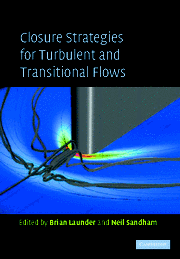19 - Compressible, High Speed Flows
Published online by Cambridge University Press: 06 July 2010
Summary
Introduction
There is an ever-increasing need to be able to predict and control high subsonic to high supersonic speed flows for the optimal design of aerospace vehicles. In this Mach number range, large variations in pressure can occur which can also lead to large density variations. Such variations in the state variables can have a significant impact on both the mean and turbulence dynamics.
Improving the prediction and control of compressible flows requires an accurate description of the large scale (structure) dynamics and of the mean and other statistical properties of the flow. Thus, a better understanding of the dynamics and improvements in the modeling of these flow features is essential. Within the framework of the ensemble-averaged Navier–Stokes equations, compressible flows have generally been computed using mass-weighted (Favreaveraged) variables. Higher-order correlations with incompressible counterparts have been modeled by variable density extensions to the incompressible form; meanwhile higher-order correlations unique to the compressible form have been isolated. Some of these compressibility terms, such as dilatation dissipation and the compressible heat flux, have been widely used. Others, such as mass flux or pressure-dilatation, have seen more limited application, as have explicit compressibility corrections to standard model terms. Many calculations have been performed neglecting (with or without justification) extra compressible terms and using simple variable density extensions of the equations.
The goal of this chapter is to provide the reader with an overall perspective of the experimental and numerical study of compressible, turbulent shear layers including the effect of shock-turbulence interactions. Concepts and relevant modeling issues associated with turbulent boundary layers, mixing layers and wakes are discussed. In addition, the effects of shock/turbulence interactions on flow field dynamics in both isotropic, homogeneous turbulence, and inhomogeneous (boundary-layer and mixing layer) flows are discussed. Coupled with some fundamental theoretical aspects of compressible turbulent flows, this should provide a summary of the current state of the art and a basis for further research.
Background: Experimental and Simulation Data
Detailed and accurate data for mean and turbulent quantities in supersonic turbulent flows are very important in order to increase our knowledge about compressible turbulent flow dynamics and develop turbulence closures. Such data can conceivably be provided by both laboratory experiments and numerical simulations (DNS, and to a more limited extent LES). However for both experiments and simulation there are additional difficulties beyond those faced for low speed flows. In this section we briefly review the current status.
- Type
- Chapter
- Information
- Closure Strategies for Turbulent and Transitional Flows , pp. 522 - 581Publisher: Cambridge University PressPrint publication year: 2002
- 5
- Cited by



